Tree diseases, pests and invasive plants represent a continued challenge to our street, park, and woodland trees. Many of these result in only cosmetic concerns, such as discolouration, however some can be a larger concern.
Open the menus below for a list of commonly occurring tree diseases, pests and invasive plants, and tips on what you can do to maintain the health of your trees.
Pests
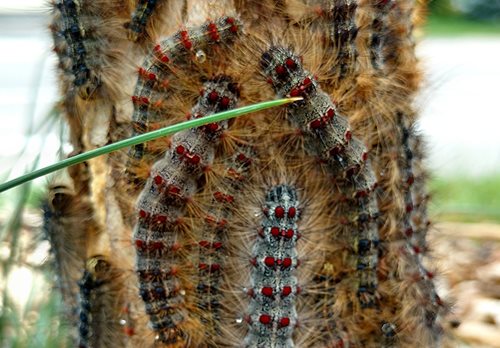
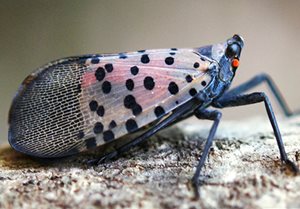
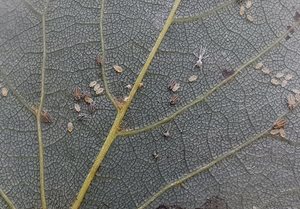
What is it?
Lymantria dispar dispar (LDD) moth (European Gypsy moth) is a non-native forest insect. LDD is considered to be a serious defoliator of trees and shrubs in North America. Mature caterpillars are 50 millimetres long, dark in colour and hairy. A row of five pairs of blue dots, followed by a row of six pairs of red dots runs down the back of the caterpillar. The male moth is light brown and slender, and the female moth is white.
Damage caused
During the larval stage, a single LDD moth caterpillar can eat an average of one square metre of leaves. This can quickly devastate trees and forests when large-scale infestations occur and defoliation becomes widespread. After severe or repeated defoliation, trees can die or become so weakened that they are vulnerable to secondary infestations.
If left untreated, LDD moths have the potential to impact 409,000 trees — about 23 per cent of the town’s tree canopy.
Tree species affected
- Oak
- Maple
- Poplar
- Birch
- Other hardwoods & conifers
What you can do
Residents are encouraged to report LDD moth infestations to ServiceOakville and to remove caterpillars when found. They can be scooped into a bucket of soapy water. Residents can also put a sticky band around the trunk of the tree to trap caterpillars in the spring. This prevents them from reaching the upper canopy and defoliating the trees. LDD moth egg masses (1 to 2 inches long, looks like felt) can also be physically removed from trees using a branch, trowel or any tool to dislodge the egg masses. To destroy the egg masses, collect them in a container filled with soapy water.
What we’re doing
The town continues to track LDD moth populations and new outbreaks.
Visit the LDD moth page for information on the town’s Integrated Pest Management (IPM) plan and notice of aerial sprays.
If a suspected case of LDD moth is called in on town property, a tree inspection will be scheduled to evaluate the health of the affected tree. Given the severity of the defoliation and size of the affected area, treatment may be considered. Action will depend on the outcome of the assessment.
What is it?
Spotted Lanternfly (Lycorma delicatula) is an invasive species found recently in north-eastern USA. First detected in 2014, it has grown and spread from the original Pennsylvania location. This pest is currently regulated by the Canadian Food Inspection Agency (CFIA) since 2018 to help prevent introduction to Canada.
The spotted lanternfly has a uniquely-coloured wings - the front wings are light brown/grey with black spots at the front and dark speckled bands near the back. The rear wings are red in colour and have black spots near the front and white and black bands at the back. The abdomen is yellow with horizontal black stripes.
Damage caused
Spotted lanternfly feed on sap that they suck from leaves and stems of host plants. They feed on many species but prefer to feed and lay eggs on tree-of-heaven (Ailanthus altissima). They have been reported to lay eggs on other species as well.
Tree species affected
- Tree-of-heaven
- Apples
- Plums
- Cherries
- Oak
- Walnut
- Poplar
- Tulip
What you can do
If you think you have seen the spotted lanternfly or signs of its damage within Oakville:
- Take a picture of the Spotted Lanternfly and/or damage.
- Capture it if possible and place it in a resealable plastic bag.
- Report your findings to ServiceOakville and the Canada Food Inspection Agency (CFIA) at 1-800-442-2342.
What we’re doing
If a suspected case of spotted lanternfly is called in on town property, a tree inspection will be scheduled and the CFIA will be contacted.
What is it?
Aphids are invasive, small, soft-bodied insects that feed on plants and trees by sucking sap from leaves and stems. They excrete a sugary substance called honeydew, which drips down on the surrounding area and promotes growth of a harmless mold that can stain leaves. Populations are at their peak during the late summer and decline with cooler weather in the fall.
Damage caused
Leaves affected by aphids can have spotty, yellow discolorations on the underside, and leaves can dry out, wilt or curl. The symptoms are mainly cosmetic and do not affect tree health or structure.
Tree species affected
- Lindens
What you can do
Most trees tolerate high populations of aphids and residents should not be concerned about the risk to their trees. Using a hard jet of water from a hose or an insecticidal soap spray can reduce their populations. Do not use broad-spectrum insecticides. They also kill ladybugs and other beneficial insects that feed on aphids or are a food source for native bird populations.
What we’re doing
If a suspected case of aphids is called in on town property, a tree inspection is scheduled to evaluate the health of the affected tree. An action plan will depend on the outcome of the assessment. Given the severity of the honeydew accumulation, treatment may be considered.
What is it?
Asian Long Horned Beetle (ALHB) is a highly destructive invasive insect, which has long segmented antennae and 20 white dots on its back. Adults are robust insects, 20-35 millimetres in length and 7-12 millimetres in width.
Female adults chew pits into the bark where they lay a single egg, resembling a grain of rice, which hatches within one to two weeks. When larvae feed on a tree’s inner bark, creating foamy sap may be visible in the pits.
Damage caused
Mature larvae bore tunnels into the tree, which structurally weaken the tree. This cuts off nutrient and water transport within the tree and the tree begins to die starting in the upper canopy and moving down. Tree leaves may wilt and the canopy may appear sparse. This eventually leads to the tree dying.
Asian Long Horned Beetles have the potential to impact 481,000 trees — about 42 per cent of the town’s leaf area.
Tree species affected
- Maple
- Birch
- Poplar
- Willow
- What you can do
If you think you have seen the beetle or signs of its damage within Oakville:
- Take a picture of the beetle or damage.
- Capture it if possible and place it in a resealable plastic bag.
- Report your findings to ServiceOakville and the Canada Food Inspection Agency (CFIA) at 1-800-442-2342.
ALHB may be confused with some native insects.
Please refer to the CFIA Asian Longhorned Beetle web page when identifying ALHB.
What we’re doing
ALHB has not been detected in Oakville, however, given the severity of a possible outbreak, the town continues to monitor for signs of its presence.
If a suspected case of ALHB is called in on town property, a tree inspection will be scheduled and the CFIA will be contacted.
What is it?
Box Elder Bugs are a pest native to Southern Ontario. Adult Box Elder Bugs are about 1/2-inch long, black with orange or red markings, including three stripes on their back, right behind the head. Their wings lay flat over their bodies, overlapping each other to form an ‘X’.
Starting in mid‑July, they move to female seed-bearing trees where they lay eggs on trunks, branches, and leaves. They are rarely found on male Manitoba maple trees.
Damage caused
Although they can be present in high numbers when feeding, there is typically no long-term health effects to the tree.
Tree species affected
- Manitoba maple
What you can do
Most trees are able to tolerate high populations of Box Elder Bugs and residents should not be concerned about the risk to their trees.
What we’re doing
Since the Box Elder Bug is native and does not significantly impact tree health or structure, there is currently no program in place to manage this insect.
What is it?
Emerald Ash Borer (EAB) is an invasive insect that attacks and kills untreated ash trees. The insect is metallic green and 8.5-13.5 millimetres in length. The adult leaves D-shaped exit holes on the bark of infected trees.
Damage caused
Females lay eggs in bark crevices, and the resulting larvae chew S-shaped paths in the living tissue of the tree. This cuts off the flow of water and nutrients to the tree, resulting in wilted or yellow foliage, and eventually, the tree will die.
Tree species affected
- All ash tree species
What you can do
Residents should remove ash trees that have not been treated. If trees have been previously treated and do not have more than 30 per cent canopy dieback, continuing treatment may preserve the tree.
Residents can also play an active role in renewing the urban forest, and replacing the canopy lost due to EAB. For more information, please visit the Tree Planting page.
What we’re doing
The town has a strategy to manage EAB in Oakville. To learn more about the town’s EAB management and canopy replacement programs, please visit the Emerald Ash Borer page.
What is it?
Cankerworm, also known as inchworm, is a native insect found throughout most of Canada. There are two species of cankerworm, spring cankerworm and fall cankerworm. The larvae vary in colour from pale green to almost black. The adult moth is grey and the female moths are wingless. After feeding, cankerworm spin down and hang from trees on thin silken webs.
Damage caused
In its larval stage, cankerworm defoliates trees. Initial feeding causes a shot-hole appearance in the leaves, but advanced feeding results in the entire leaf being eaten. Healthy trees will usually survive a moderate single-year defoliation. At normal population levels, cankerworms are an important food supply for many of the native species of birds that live in Oakville’s urban forest.
Tree species affected
- Manitoba maple
- American elm
- Ash
- Basswood
- Bur oak
- Siberian elm
- Aspen
- White birch
- Fruit trees
What you can do
Residents can band tree trunks with a sticky material to trap the wingless female moths. This prevents their movement to the upper canopies of trees where they lay their eggs. Sticky bands must be applied in the autumn and early spring. If concerned regarding the safety of a town tree, please call ServiceOakville at 905-845-6601.
What we’re doing
In spring 2022, the town completed an aerial spray application of the biological treatment Bacillus thuringiensis Kurstaki (BtK) to control LDD (European Gypsy) Moth and cankerworm infestation levels in town woodlands. For more information, visit our LDD Moth page.
If a suspected case of cankerworm is called in on town property, a tree inspection is scheduled to evaluate the health of the affected tree. Given the severity of the defoliation and size of the affected area, treatment may be considered. Action will depend on the outcome of the assessment.
What is it?
Forest tent caterpillars are native to North America and are a widespread defoliator of hardwood trees. Outbreaks occur every 10 to 12 years and can last three to six years. Adult moths are brown with three dark bands across each forewing and are active from late June to early August. Eggs are laid in bands of 100 or more and cemented together to completely encircle twigs. Larvae emerge in the spring during bud break. The full-grown caterpillar is 50 millimetres long, brown, hairy, and has a blue stripe along each side along with keyhole-shaped white spots along the back.
Contrary to their name, forest tent caterpillars do not form a tent, and should not be confused with eastern tent caterpillars.
Damage caused
Forest tent caterpillars defoliate trees. Severe and sustained infestation can reduce the growth of trees and kill branches. This can result in tree death, especially if the tree is already stressed.
Tree species affected
- Trembling aspen & other poplars
- White birch
- Sugar maple
- Oak
What you can do
If an infestation is noticed during the spring, remove the caterpillars from the tree and place them into a bucket of soapy water. If egg clusters are noticed during the winter, these can be removed and destroyed. If you are worried about the safety of an infected town tree, please call ServiceOakville.
What we’re doing
If a suspected case of forest tent caterpillar is called in on town property, a tree inspection will be scheduled to evaluate the health of the affected tree. Depending on the severity of the defoliation and size of the affected area, treatment may be considered. Action will depend on the outcome of the assessment.
What is it?
The Hemlock Woolly Adelgid (HWA) is an aphid-like insect. The HWA egg sacs look like small cotton balls or clumps of snow located at the base of needles. Wind, animals and human activity can spread HWA.
Hemlock Woolly Adelgid were detected in Ontario in Etobicoke in 2012 and Niagara Falls in 2013. These populations have since been destroyed, and the region continues to be monitored for new infestations.
In 2017, HWA was detected in southwestern Nova Scotia.
Hemlock woolly adelgid was detected in Ontario in the spring of 2023.
Damage caused
HWA attacks and kills hemlock trees by feeding on nutrient and water storage cells at the base of needles.
Tree species affected
- Hemlock
What you can do
If you suspect a town tree of being infested with HWA, please call ServiceOakville at 905-845-6601 with the location and approximate size of the infestation.
Residents should monitor their privately owned hemlock trees to ensure early detection of HWA.
What we’re doing
If a suspected case of HWA is called in on town property, a tree inspection will be scheduled to evaluate the health of the affected tree and the CFIA will be notified.
The town is proactively surveying all inventoried Hemlocks on its streets and parks, as well as woodland areas, to detect if HWA is present. Results have indicated that HWA is not present in Oakville at this time.
What is it?
Box Tree Moth (Cydalima perspectalis) is a newly found invasive species in Ontario. First detected in 2018, it has grown and spread throughout the Greater Toronto Area. This pest is currently regulated by the Canadian Food Inspection Agency (CFIA). The CFIA have enacted restrictions on the movement of Buxus material through Ontario.
There are no native boxwoods in Canada. Boxwoods were originally brought to North America as nursery stock from Europe and Asia, bred, and sold as an ornamental. Thus, they are found in urban areas only, planted around houses and in small gardens. There are no natural stands of boxwood in Canada.
Damage caused
Box tree moth, in its larval stage, defoliates boxwoods, and severe outbreaks can also feed on the bark and cause mortality.
Tree species affected
- Boxwood shrubs, (Buxus Sp.)
What you can do
Bacillus thuringiensis kurstaki (Btk) is a selective biological insecticide that controls caterpillars and can be used to control box tree moth. Bacillus thuringiensis kurstaki crystals release a toxic protein when dissolved in the alkaline digestive system of the insect. The insecticide causes the caterpillar to stop feeding and it dies a short time after. Other insects, mammals, birds, and fish are not affected by Bacillus thuringiensis kurstaki.
To dispose of any dead or infected material, follow a heat treatment method.
- Place plant material in a sealed black plastic bag and expose it to 48 hours of direct sunlight.
- Following heat treatment, dispose of the sealed bag in your garbage pickup.
What we’re doing
The town is monitoring for incoming calls regarding the presence of Box Tree Moth and retaining information should the CFIA need it. As the province has been declared a regulated area, only sightings outside of Ontario need to be reported to the CFIA.
Diseases
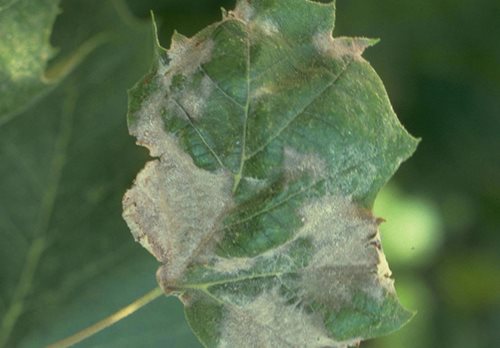
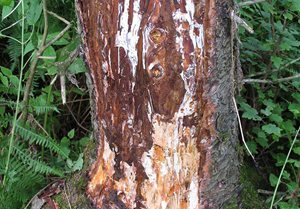
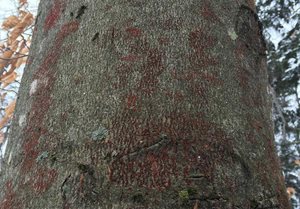
What is it?
Anthracnose is a general term for a group of fungal diseases that cause similar symptoms. It attacks young shoots and leaves, and causes the formation of brown spots and whitish patches on the leaves. It can also spread to the entire leaf. Moist, cool weather conditions in the spring contribute to the spread and outbreak of anthracnose.
Damage caused
Anthracnose can stress trees, but is often not the sole cause of tree death.
Tree species affected
- Sycamore
- Ash
- Oak
- Maple
- Ironwood
- Basswood
What you can do
Proper fall maintenance can reduce the outbreak of anthracnose in future years. Rake and remove fallen leaves from beneath infected trees to reduce the risk of infection of new leaves emerging in the spring. If concerned regarding the safety of an infected town tree, please call ServiceOakville at 905-845-6601.
What we’re doing
If a suspected case of anthracnose is called in on town property, a tree inspection is scheduled to evaluate the health of the tree. Given that anthracnose is typically not a primary cause of tree death, there are currently no programs in place to treat it.
What is it?
An infection begins when a fungus, living in the ground, sends out filaments that invade roots. It then moves to the root collar, and spreads to the tree trunk. Infected trees tend to show a felt-like whitish layer of fungal threads between the inner bark and outer sapwood.
Clusters of overlapping honey-coloured mushrooms at the bases of trees are a sign of this root rot.
Damage caused
The upper foliage of trees affected by Armillaria root rot become sparse, and leaves are undersized. Twigs may die. The spread of infection induces sapwood (the soft outer layers of recently formed wood) to decay, eventually killing the tree.
Tree species affected
- Oak
- Other deciduous and evergreen trees and shrubs
What you can do
Monitor the health of trees on your property and learn how to maintain your trees by visiting our tree maintenance page. If concerned regarding the safety of an infected town tree, please call ServiceOakville at 905-845-6601.
What we’re doing
If a suspected case of Armillaria root rot is called in on town property, a tree inspection is scheduled to evaluate the health of the tree. Depending on results of the inspection, the health, structure and integrity of the tree, action may be required and undertaken.
What is it?
Beech bark disease is caused by a combination of a non-native scale insect and a nectria fungus that targets mature beech trees. The insect feeds on the trees through bark cracks and crevices. This allows spores of the Nectria fungus to enter the bark and produce cankers and/or red blisters that cover much of the trunk.
Damage caused
Beech bark disease results in severe leaf die-back and cankering, and in many cases causes the tree to die.
Tree species affected
- American Beech
- European Beech
What you can do
Monitor the health of any mature beech trees on your property. Do not move firewood since beech scale insects and fungus can spread from infested areas to non-infested areas. If concerned regarding the safety of an infected town tree, please call ServiceOakville at 905-845-6601.
What we’re doing
If a suspected case of beech bark disease is called in on town property, a tree inspection is scheduled to evaluate the health of the tree. Depending on results of the inspection, the health, structure and integrity of the tree, action may be required and undertaken.
What is it?
The butternut canker initially affects trees through buds, leaf scars, or wound openings in the bark. Spores produced on the branches spread down the tree by rain, which results in many trunk cankers, which eventually girdle the infected tree. In the spring, inky-black secretions exude from the cracks in the canker. In the summer, the cankers have a sooty, black, patchy appearance with a white margin.
Damage caused
Cankers spread around the branches and trunk of the tree, eventually girdling and killing the tree.
Tree species affected
- Butternut
What you can do
Monitor the health of any butternut trees on your property, and ensure they have favourable growing conditions. There is no control method once butternut trees are infected. If concerned regarding the safety of an infected town tree, please call ServiceOakville at 905-845-6601.
What we’re doing
If a suspected case of butternut canker is called in on town property, a tree inspection is scheduled to evaluate the health of the tree. Depending on results of the inspection, the health, structure and integrity of the tree, action may be required and undertaken.
What is it?
Dutch elm disease is a fungus that was heavily present in Ontario in the 1960’s and 70’s. It caused the widespread mortality of elm trees. The European elm bark beetle and the native elm bark beetle spread the fungus. The beetles dig galleries underneath the bark of infected trees. In spring, the bark beetles emerge, covered in fungal spores. They then attach to and feed on healthy trees.
Dutch elm disease persists on native elms within woodland areas.
Damage caused
The fungus develops in the live tissue under the bark and leads to browning and wilting of the foliage. Once infected, the tree will inevitably die in one to three years.
Tree species affected
- White Elm
- American Elm
- Rock Elm
- Slippery Elm
What you can do
If you notice an elm, declining rapidly, it may be due to Dutch Elm Disease. If you are concerned that the tree may be hazardous, please call ServiceOakville at 905-845-6601 with the location and size of the tree.
What we’re doing
Currently, the town is planting Elm species that are resistant to the disease.
If a suspected case of Dutch Elm Disease is called in on town property, a tree inspection is scheduled to evaluate the health of the tree. If the tree is located near active trails or private property, the tree will be removed.
What is it?
Maple bladder gall mite feeds on leaves, causing abnormal growth in the leaf that encloses the mite. This swelling, forms the green and pinkish galls which take on a wart-like appearance on the upper surface of the leaves, usually affecting silver and red maples. Maple spindle gall mite causes spindle-like growths on the upper surface of leaves, usually affecting sugar maples.
Damage caused
Although gall formation can be especially prevalent some years, maple galls are only a cosmetic issue and do not affect tree health.
Tree species affected
- Silver Maple
- Red Maple
- Sugar Maple
What you can do
Given that the formation of galls do not typically affect tree health, control methods are not required. If concerned regarding the safety of an infected town tree, please call ServiceOakville at 905-845-6601.
What we’re doing
Given that maple galls only results in a cosmetic change, and do not usually affect tree health, there is no current program in place to treat maple galls.
What is it?
Oak wilt is a fungus that primarily affects Oaks. Similar to Dutch elm disease, the fungus blocks the movement of water and nutrients through affected trees. It has a particularly high mortality rate affecting the oak family.
Two primary vectors, root contact and beetle movement spread the oak wilt fungus.
Movement of infected wood causes the infection to spread and is discouraged.
Damage caused
Once infected, leaves become discoloured and begin to wilt. The fungus can be located beneath the bark of infected trees and appears as gray or tan mats. Trees will die shortly after infection.
Tree species affected
- Oaks
What you can do
To protect private oak trees from oak wilt, do not prune them during spring and early summer. Spring and early summer is when the beetles responsible for the spread of the fungus are active and the risk of infection is high. If necessary, it is best to prune or remove oaks during the winter months. Consult a forestry professional to ensure appropriate measures are taken to dress any wounds as needed.
Do not move firewood as oak wilt is spread by the movement of infected wood.
If you suspect a case of oak wilt present within Oakville, please notify the town immediately by calling 905-845-6601.
What we’re doing
Oak wilt has not been identified in Oakville at this time. It has recently been found within Ontario, in the Niagara and Barrie areas. The town is actively monitoring its movement, while preparing operating procedures that can reduce its spread.
The town has taken steps to avoid pruning and removal of oaks during the active growing season to reduce the risk of the spread of oak wilt.
What is it?
Tar spot is caused by fungi. Fungal spots resembling tar appear on the leaves. These spots do not affect tree health, rather, this is only a cosmetic problem. The fungal spores within the tar spots can survive winter. Fallen leaves from the previous season can release spores, which infect emerging leaves the following spring.
Damage caused
Tar spots are only a cosmetic issue, and do not affect tree health.
Tree species affected
- Maples
What you can do
Rake up fallen leaves to reduce the number of fungal spores, which survive through winter to the next spring.
What we’re doing
Given that tar spot only results in a cosmetic change, and does not usually affect tree health, there is currently no program in place to treat tar spot.
Invasive plants
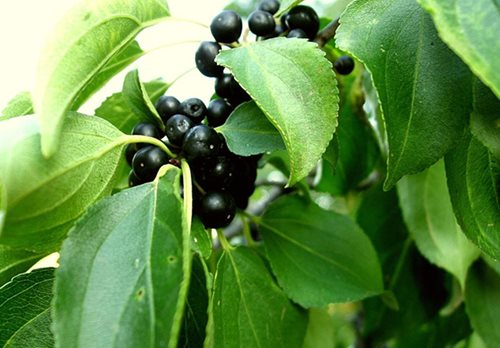
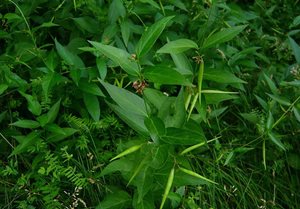
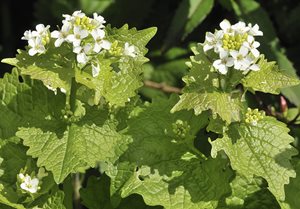
What is it?
Buckthorn is an invasive shrub. It is the first to leaf out in the spring and the last to drop its leaves in the fall. It can grow to be two to three metres tall. Smooth dark green leaves are finely toothed and have an opposite arrangement around the stem. Most branches end in a short, sharp thorn. Common buckthorn has flowers with two to six small yellow or green petals, and in the late summer or fall, the shrub produces clusters of black berry-like fruit.
Common buckthorn is not to be confused with native dogwood. For more information, please visit Invasive Species Common Buckthorn website.
Damage caused
Buckthorn produces a large number of seeds that germinate quickly and alter nitrogen levels in the soil, creating better conditions for its own growth. When buckthorn outcompetes native berry-producing plants and shrubs, it replaces native food sources, which are more nutritious, thereby negatively affecting wildlife. Buckthorn dominates the understory and prevents the growth of native wildflowers, shrubs and trees. Early detection and removal of buckthorn is essential for preventing establishment.
What you can do
- Small plants can be removed by hand pulling but be sure to get the full root system out.
- Plants that are bigger than a seedling will need to be dug out with a shovel or removed with a lever tool.
- Place a tarp over cut stems to discourage new growth.
- Dispose of invasive plants in the garbage. Do not put them in the compost or discard them in natural areas as this causes further spread.
- If full removal of the buckthorn plant is not possible, remove and destroy the berries to limit the spread of this invasive plant and its impact on wildlife.
- On private property, removal of buckthorn with a trunk greater than 15 centimetres in diameter requires a private tree removal permit but is exempt from fees.
What we’re doing
The town removes and treats buckthorn on town property through our Woodland Regeneration Program. The area may be treated to prevent reoccurrence. In 2018, through the Woodland Regeneration Program, over 50 hectares of buckthorn was treated.
What is it?
Dog strangling vine refers to two similar species, black and pale swallowwort. It has pink to dark purple star shaped flowers and forms long seed pods in the late summer. Dog strangling vine was originally planted in the 1800’s for use in gardens. Dog strangling vine is a restricted species under the Provincial Invasive Species Act, 2015.
For more information on how to identify this invasive plant, please visit Ontario Government's dog-strangling vine website.
Damage caused
Dog strangling vine is very aggressive and overtakes native vegetation. It creates interwoven mats, preventing the growth of native flowers and shrubs, as well as forest regeneration.
What you can do
Hand pull plants growing on private property by pulling from as close to the ground as possible. Place pulled plants into garbage bags for disposal and tie shut.
If you suspect a patch of dog strangling vine on town property:
- Call ServiceOakville at 905-845-6601.
- Provide the closest address and approximate size of the affected area.
What we’re doing
The town will inspect and treats dog-strangling vine on town property through our Woodland Regeneration Program. Depending on the size of impacted area and severity, attempts will be made to treat the area to prevent reoccurrence.
What is it?
Garlic mustard is a common invasive plant in Oakville and across Southern Ontario. It has two life stages during its first two years:
- The first year is characterized by a rosette arrangement of dark green kidney-shaped leaves, which release a strong garlic odour when crushed.
- In their second year, plants that survive winter produce flowers along with hundreds of seeds.
For more information on how to identify this invasive plant, please visit Invasive Species Garlic Mustard website.
Damage caused
Garlic mustard is one of the greatest threats to woodlands in Oakville and across Ontario. This invasive plant displaces native wildflowers and plants, including White Trilliums. Garlic mustard does not provide a valuable food source for native wildlife and takes the place of other native plants and shrubs that do.
What you can do
Hand-pull plants on private property from as close to the ground as possible to ensure roots are removed along with the plant. Place pulled plants into garbage bags, tie them shut and leave them in the sun for a couple of days before disposing of the plants.
The Town of Oakville collaborates with Oakvillegreen and other groups to organize tree planting and stewardship activities, including garlic mustard weeding events.
If you suspect a patch of garlic mustard on town property:
- Call ServiceOakville at 905-845-6601.
- Provide the closest address and approximate size of the affected area.
What we’re doing
Some recent research has indicated that pulling garlic mustard where it is abundant prolongs its run. It also robs a great deal of nitrogen, macro-and micronutrients, and organic matter from the ecosystem.
The town will inspect garlic mustard that is growing on town property. Depending on the size of impacted area and severity, attempts will be made to treat the area to prevent reoccurrence.
What is it?
Giant hogweed is a large, invasive plant. Its sap contains chemicals that can cause skin to become hypersensitive to sunlight and erupt in painful blisters. During the first year, the plant produces a rosette of leaves, which can reach one metre in height. After two to five years, the plant produces flowers. The stems of the plant are covered in reddish purple flecks and stiff hairs that are filled with sap.
For more information on how to identify this invasive plant, please visit the Giant Hogweed and Wild Parsnip page.
Damage caused
Hogweed can shade out native plants. The watery sap of this invasive plant can cause severe inflammation of the skin and severe eye irritation.
What you can do
If you identify giant hogweed on town property:
- Call ServiceOakville at 905-845-6601.
- Provide the closest address and approximate size of the affected area.
- Do not attempt to remove or touch the plant.
What we’re doing
The town will inspect and remove giant hogweed that is occurring on town property, so that it does not grow along park paths and groomed trails. The area will be treated as needed.
What is it?
Himalayan balsam is an invasive annual herb, identifiable by its orchid shaped flowers, that is newer to the Oakville area. It often occurs on floodplain sites, as watercourses assist with them colonizing new areas. When in seed, Himalayan balsam can eject its seeds up to a distance of five metres.
For more information on how to identify this invasive plant, please visit Invasive Species Himalayan Balsam website.
Damage caused
Himalayan balsam grows rapidly and creates dense stands, pushing out native plants and reducing biodiversity.
What you can do
Hand-pull plants growing on private property by pulling from as close to the ground as possible. Place pulled plants into garbage bags for disposal and tie them shut.
If you suspect a patch of Himalayan Balsam on town property:
- Call ServiceOakville at 905-845-6601.
- Provide the closest address and approximate size of the affected area.
What we’re doing
The town will inspect Himalayan Balsam that is occurring on town property. Depending on the size of impacted area and severity, attempts will be made to treat the area to prevent reoccurrence.
What is it?
Japanese knotweed is a semi-woody perennial plant, which spreads widely through underground rhizomes. It can grow to be three metres high, the stems have the appearance of bamboo, and its flowers are greenish white. It is very aggressive and overtakes native vegetation. Japanese knotweed is a restricted species under the Provincial Invasive Species Act 2015.
For more information on how to identify this invasive plant, please visit Invasive Species Japanese Knotweed website.
Damage caused
Japanese knotweed spreads quickly, degrades native wildlife habitat, and reduces biodiversity by outcompeting other native plants and shrubs. Its root system has been known to break through asphalt and concrete.
What you can do
If you detect Japanese knotweed on your private property, learn how to manage it effectively. Refer to Japanese Knotweed – Best Management Practices in Ontario (pdf).
If you suspect a patch of Japanese knotweed on town property:
- Call ServiceOakville at 905-845-6601.
- Provide the closest address and approximate size of the affected area.
What we’re doing
The town will treat Japanese knotweed that is occurring on town property. Attempts will be made to treat the area to prevent reoccurrence. Management of this invasive species can take several years to ensure it is eradicated from the area.
What is it?
Wild parsnip is an invasive species that can grow to be one and a half metres tall. It can be identified by its smooth stem which can be two to five centimetres thick and its clusters of yellowish-green flowers which grow to be 10-20 centimetres wide. The leaves have two to five leaflets which grow across from one another along the stem. The leaflets are sharply toothed and shaped like mittens.
For more information on how to identify this invasive plant, visit Oakville's Giant Hogweed and Wild Parsnip page or the Ontario government's wild parsnip - invasive species page.
Damage caused
Wild parsnip forms dense stands, which outcompete native plants, thus reducing biodiversity and negatively affecting habitat. Similar to giant hogweed, the sap of wild parsnip plants can also cause skin irritations, burns, or blisters.
What you can do
If you identify wild parsnip on town property:
- Call ServiceOakville at 905-845-6601.
- Provide the closest address and approximate size of the affected area.
- Do not attempt to remove or touch the plant.
What we’re doing
In response to reports of wild parsnip on town property, the town will do an inspection. Depending on severity and size of the affected area, town staff will treat wild parsnip so that it does not grow along park paths and groomed trails.
- Garbage & Recycling